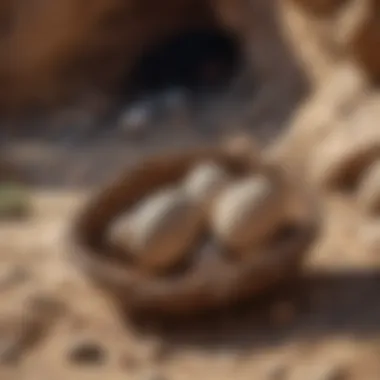Unveiling the Enigmatic World of Dinosaur Eggs: An In-Depth Exploration


Rock and Fossil Inditficatoin
Rock and fossil identification play a crucial part in unraveling the mysteries of dinosaur eggs. When exploring the realm of prehistoric life, understanding the types of rocks and fossils that surround these ancient marvels becomes paramount. One must pay close attention to specific characteristics indicative of different rock types and fossils. Tracing the lineage of dinosaurs through the identification of these materials can provide invaluable insights into their habitat, behavior, and evolution. To aid in this process, various tools such as magnifying glasses, chisels, and rock hammers are indispensable for accurate identification and analysis of rocks and fossils.
Collecting Tips and Techniques
Delving into the world of dinosaur eggs involves the intricate task of collecting specimens with precision and care. To uphold best practices in collecting, aspiring paleontologists must familiarize themselves with the terrain, keeping an eye out for prime collecting sites where dinosaur eggs are likely to be nestled. Utilizing specialized tools like brushes and dental picks, they can safely extract these delicate specimens from the earth without causing damage. It is crucial to exercise caution and patience during the extraction process to ensure the preservation of these invaluable relics.
Preservatoin and Display
Preservation and display techniques are essential in conserving dinosaur eggs for future study and admiration. Employing specific preservation methods such as coating fossils with consolidants or storing rocks in a controlled environment prevents deterioration and safeguards their structural integrity. Proper storage practices, including utilizing acid-free containers and archival tissue paper, are instrumental in maintaining the quality of these fragile artifacts. When it comes to creative display ideas, showcasing dinosaur eggs in shadow boxes or museum-quality display cases can enhance their visual appeal while providing a glimpse into the prehistoric past.
Geolgical Insigths
Gaining geological insights is fundamental to grasping the context in which dinosaur eggs were laid and preserved. Studying the geological formations and processes that occurred during the Mesozoic era sheds light on the ancient environments where dinosaurs roamed. The historical significance of rocks and fossils extends beyond mere artifacts, offering a window into Earth's past and the evolution of life. Notable discoveries in the field of paleontology have unearthed exceptional specimens that have revolutionized our understanding of dinosaurs and their reproductive behaviors.
Introduction
Dinosaur eggs have long been a subject of fascination in the field of paleontology, offering a window into the ancient world of these magnificent creatures. In this comprehensive guide on unveiling the mysteries of dinosaur eggs, we delve into the significance of these archaeological treasures and the invaluable insights they provide into the evolutionary history of dinosaurs. From the biological processes of egg formation to the behavioral and environmental clues they offer, dinosaur eggs hold a wealth of information waiting to be uncovered.
Evolutionary Significance
The Role of Dinosaur Eggs in Understanding Evolutionary History
Dinosaur eggs play a pivotal role in unraveling the evolutionary history of these prehistoric beings. By studying the characteristics and distribution of dinosaur eggs, researchers can trace the evolution of different species, shedding light on their growth and development over millions of years. The fossilized remains of these eggs offer a unique glimpse into the reproductive strategies and life cycles of dinosaurs, providing crucial evidence for understanding their place in the larger evolutionary timeline.
Implications of Egg Fossils in Paleontological Research
The discovery of egg fossils has revolutionized paleontological research, offering new avenues for exploration and interpretation. By analyzing the morphology and composition of these fossilized eggs, scientists can infer vital information about ancient ecosystems and the behavior of various dinosaur species. The study of egg fossils not only contributes to our understanding of dinosaur reproduction but also provides valuable insights into environmental conditions and ecological dynamics during the Mesozoic era.
Brief History


Earliest Discoveries of Dinosaur Egg Fossils
The earliest discoveries of dinosaur egg fossils date back to the 19th century, marking a significant milestone in the study of paleontology. These initial findings laid the foundation for future research on dinosaur reproduction and nesting behaviors, sparking a wave of interest and curiosity among scientists and enthusiasts alike. The excavation of these ancient relics has offered unparalleled opportunities to explore the mysteries of dinosaur reproduction and unravel the secrets of their prehistoric existence.
Key Milestones in the Study of Dinosaur Eggs
Over the years, key milestones in the study of dinosaur eggs have expanded our knowledge and deepened our appreciation for these remarkable artifacts. From the development of new analytical techniques to the discovery of rare egg specimens, each milestone has pushed the boundaries of paleontological research and enhanced our understanding of dinosaur biology. These milestones serve as markers of progress in unraveling the secrets of dinosaur eggs, paving the way for further discoveries and revelations in the field of paleontology.
Formation of Dinosaur Eggs
Diving into the intriguing realm of dinosaur eggs, the topic of Formation of Dinosaur Eggs stands as a pivotal cornerstone in unravelling the mysteries of prehistoric life. Understanding the biological processes behind the creation of these ancient marvels not only provides insight into dinosaur reproduction but also offers a glimpse into the environmental conditions of that era. The significance of comprehending egg formation lies not only in its contribution to paleontological research but also in deciphering the evolutionary paths undertaken by these majestic creatures. Exploring the types and characteristics of dinosaur eggs could unlock essential clues about the diversity of species, reproductive habits, and ecological adaptations of dinosaurs.
Biological Process
Understanding how dinosaurs laid and hatched eggs
The intricate process of how dinosaurs laid and hatched their eggs holds a wealth of information crucial to our understanding of prehistoric life. Delving into this specific aspect sheds light on the reproductive behaviors of dinosaurs and provides valuable insights into their nesting habits. By unraveling the mechanisms behind egg-laying, researchers can deduce the size of nests, clutch sizes, and potential parental care exhibited by various dinosaur species. This knowledge aids in reconstructing ancient ecosystems and comprehending the survival strategies employed by dinosaurs for the continuation of their species.
Factors influencing egg formation and shell composition
Exploring the factors that influenced egg formation and shell composition unveils the complexities of dinosaur reproduction. Understanding the environmental conditions, such as temperature and humidity, that dictated egg formation is paramount in deciphering the adaptability of dinosaurs to varying climates. Moreover, studying the composition of eggshells provides invaluable data on the physiological constraints and protective mechanisms that facilitated the survival of dinosaur embryos. Analyzing these factors offers a glimpse into the evolutionary pressures that shaped dinosaur reproduction and underscores the importance of adaptation in prehistoric ecosystems.
Types of Dinosaur Eggs
Diversity in dinosaur egg shapes and sizes
The diversity displayed in dinosaur egg shapes and sizes showcases the wide array of reproductive strategies adopted by different dinosaur species. By examining these variations, scientists can infer the evolutionary relationships between dinosaurs and correlate egg morphology with behavioral traits. Investigating the differences in egg structures not only highlights the adaptability of dinosaurs to their environments but also underscores the uniqueness of each species' reproductive biology. Understanding the diverse range of egg shapes and sizes enriches our knowledge of dinosaur evolution and emphasizes the intricate nature of prehistoric life.
Distinct features of different dinosaur egg species
Exploring the distinct features of various dinosaur egg species provides key insights into the classification and evolution of dinosaurs. By categorizing eggs based on their characteristics, such as shell thickness and pore patterns, researchers can identify possible links between different dinosaur lineages and their reproductive strategies. Recognizing these unique features enables the reconstruction of ancient habitats and the development of hypotheses regarding parental care behaviors among dinosaurs. Examining the distinct traits of different egg species deepens our comprehension of dinosaur diversity and fosters discoveries about the evolutionary forces that shaped these majestic creatures.
Discovery and Excavation


In this enlightening section of our comprehensive guide on unravelling the mysteries of dinosaur eggs, we delve into the pivotal aspect of Discovery and Excavation. The process of unearthing and studying these ancient remnants plays a crucial role in expanding our understanding of prehistoric life. Exploration and excavation enable researchers to uncover invaluable insights into the world of dinosaurs, providing a window into a bygone era. Excavations of dinosaur egg sites require meticulous planning and execution, ensuring the preservation of delicate fossils that have the potential to rewrite history books.
Paleontological Expeditions
Challenges faced in finding and preserving dinosaur egg fossils
A fundamental aspect of paleontological expeditions revolves around the challenges encountered in locating and safeguarding dinosaur egg fossils. The rugged terrains where these fossils are often found present arduous obstacles for researchers, requiring dedication and resilience in their pursuit. Preservation issues further complicate the process, as fossilization is a delicate phenomenon that demands utmost care to prevent deterioration. Despite these challenges, the reward of discovering pristine dinosaur eggs fuels the passion of paleontologists worldwide in their quest to unveil ancient mysteries.
Notable discoveries that revolutionized our understanding of dinosaurs
Highlighting the significant impact of certain discoveries, these groundbreaking findings have reshaped our perceptions of dinosaurs. From unearthing complete egg nests to identifying new species based on egg characteristics, these discoveries have propelled paleontological research to new heights. Understanding the context in which these fossils were found is paramount, as it provides crucial clues about the behavior and ecology of the dinosaurs that once roamed the Earth. Each notable discovery serves as a cornerstone in the ever-evolving narrative of prehistoric life, pushing the boundaries of our knowledge and sparking further curiosity.
Scientific Techniques
Advanced methods used to study and analyze dinosaur egg remains
Exploring the realm of advanced scientific techniques unveils a treasure trove of methods utilized in dissecting the intricate details of dinosaur egg remains. From high-resolution imaging techniques to chemical analysis of fossilized shells, researchers employ a multidisciplinary approach to glean insights from these ancient artifacts. These sophisticated methods not only reveal the structure and composition of dinosaur eggs but also shed light on the nesting habits and biological characteristics of the ancient reptiles.
Contributions of modern technology to paleontological research
Modern technology has ushered in a new era of paleontological research, revolutionizing the way we study and interpret dinosaur egg fossils. Cutting-edge tools such as CT scans and virtual reconstruction software have enabled researchers to create digital replicas of fragile specimens, preserving them for future generations. The integration of technological advancements has not only expedited the analysis process but has also enhanced the accuracy and depth of our understanding of dinosaur eggs. By leveraging modern technology, paleontologists continue to push the boundaries of scientific exploration, uncovering hidden secrets buried within the annals of time.
Interpreting Dinosaur Egg Findings
In this section, we delve into the crucial aspect of interpreting dinosaur egg findings, a pivotal component of understanding prehistoric life. By examining the remnants of these ancient artifacts, paleontologists can uncover valuable insights into the behaviors and environmental conditions of dinosaurs. Deciphering the clues left behind by these eggs allows us to reconstruct the past with remarkable precision, offering a glimpse into the world of these majestic creatures. Our exploration will focus on the significance of behavioral insights and environmental clues derived from dinosaur egg findings, illuminating the rich tapestry of information encapsulated within these fossilized relics.
Behavioral Insights
Evidence of nesting behaviors and parental care in dinosaurs
Exploring the evidence of nesting behaviors and parental care in dinosaurs provides a window into the intimate lives of these ancient reptiles. By studying the way in which dinosaurs built nests and cared for their young, scientists can piece together a more comprehensive picture of their social structures and reproductive habits. The meticulous examination of fossilized nesting sites offers valuable information on the nurturing behaviors exhibited by various dinosaur species. This particular aspect sheds light on the maternal instincts and communal living arrangements prevalent among different dinosaur groups, showcasing the diverse range of parenting strategies that existed in the prehistoric world.
Social structures inferred from dinosaur egg clusters


The study of social structures inferred from dinosaur egg clusters unveils a nuanced understanding of how dinosaurs interacted within their communities. By analyzing the arrangement and distribution of egg clusters, researchers can infer the hierarchical organization and social dynamics of these creatures. The clustering patterns provide insights into group behaviors, such as communal nesting practices and territorial habits. This aspect grants us a glimpse into the intricate social fabric of dinosaurs, highlighting the cooperative behaviors and potential alliances that shaped their group interactions. Understanding these social structures adds depth to our comprehension of dinosaur behavior and ecosystem dynamics.
Environmental Clues
Impact of climate and habitat on dinosaur egg preservation
Examining the impact of climate and habitat on dinosaur egg preservation is integral to unraveling the environmental conditions that influenced egg fossilization. The preservation of dinosaur eggs is intricately linked to factors such as temperature, humidity, and geological settings. By studying the state of fossilized eggs and their surrounding sediment, scientists can infer the climatic conditions prevalent during the time of deposition. This analysis provides valuable data on the ecological preferences of different dinosaur species and offers insights into the environmental challenges they faced. Understanding how climate and habitat affected egg preservation enhances our knowledge of prehistoric ecosystems and the adaptations of dinosaurs to varying environmental contexts.
Indications of ecological conditions based on egg fossil locations
Analyzing the locations of egg fossils offers intriguing glimpses into the ecological landscapes inhabited by dinosaurs. The distribution of egg sites provides clues about the microhabitats preferred by different dinosaur species and the geological contexts conducive to egg laying. By correlating fossil locations with sediment composition and surrounding flora, researchers can reconstruct the environmental conditions of ancient nesting grounds. This aspect allows us to paint a vivid picture of the ecosystems where dinosaurs thrived, shedding light on the biodiversity, vegetation, and geographical features of these prehistoric environments. Deciphering the ecological clues preserved within egg fossil locations enriches our understanding of the complex interplay between dinosaurs and their habitat.
Current Research and Future Prospects
In the fifth segment of the article, we delve into the crucial aspect of current research and potential future prospects within the realm of dinosaur eggs. This section serves as a gateway to unveiling the cutting-edge advancements and upcoming possibilities that promise to revolutionize paleontological understanding. Emphasizing the significance of ongoing research endeavors and the promising trajectories for future exploration, we aim to provide a comprehensive insight into the dynamic landscape of dinosaur egg studies in contemporary times. Propelling beyond the realms of traditional methodologies, researchers are now leveraging state-of-the-art technologies to unlock the mysteries encapsulated within fossilized dinosaur egg structures. By venturing into uncharted territories and embracing the unknown frontiers, scientists are poised to unearth invaluable revelations that could reshape our understanding of prehistoric life forms.
Technological Advancements
Among the several focal points under current research and future prospects, one pivotal area of interest is the emergence of advanced tools for studying microscopic details of dinosaur egg structures. These innovative tools offer a microscopic view into the intricate composition and unique characteristics of dinosaur egg fossils, allowing researchers to unravel hidden information embedded within these ancient relics. By harnessing the capabilities of these cutting-edge technologies, scientists can gain unprecedented insights into the evolutionary history and biological mechanisms surrounding dinosaur egg formation. An essential characteristic of these tools lies in their ability to magnify minuscule details with exceptional precision, enabling researchers to decipher elusive clues that may have eluded previous investigations.
Emerging tools for studying dinosaur egg structures at a microscopic level
-Discuss the specific aspect of emerging tools for studying dinosaur egg structures at a microscopic level and its contribution to the overall research objectives of the article. The deployment of advanced imaging tools has significantly enhanced our capacity to explore the microscopic intricacies of dinosaur egg structures. These tools facilitate a deeper understanding of the organic and inorganic components composing the eggshells, shedding light on the environmental conditions and biological processes prevalent during the dinosaur's lifetime. Particularly beneficial for researchers, these tools aid in reconstructing the past narratives enclosed within fossilized remnants, offering a glimpse into the ancient worlds these majestic creatures inhabited. -Describe the unique feature of emerging tools for studying dinosaur egg structures at a microscopic level and its advantages/disadvantages in this article. One distinct feature of these cutting-edge tools is their ability to perform non-destructive analyses, preserving the delicate nature of dinosaur egg fossils while extracting invaluable data. This non-invasive approach ensures the conservation of precious specimens, safeguarding against potential damages that could impede future investigations. However, navigating the complexities of microscopic examinations requires meticulous attention to detail and expert calibration to extract accurate data, presenting a challenge in interpreting the vast amounts of information generated by these sophisticated technologies.
Potential breakthroughs in DNA analysis of fossilized dinosaur eggs
-Discuss the specific aspect of potential breakthroughs in DNA analysis of fossilized dinosaur eggs and its contribution to the overall research objectives of the article. The frontier of DNA analysis in fossilized dinosaur eggs holds the promise of unlocking genetic secrets embedded within these ancient remnants. By leveraging advancements in molecular techniques, researchers can delve into the genetic blueprints of dinosaurs, unraveling evolutionary relationships and potential hereditary traits passed down through generations. This groundbreaking approach opens up avenues for exploring the evolutionary pathways of dinosaurs and tracing genetic lineages to uncover hidden connections across species boundaries. -Describe the unique feature of potential breakthroughs in DNA analysis of fossilized dinosaur eggs and its advantages/disadvantages in this article. An exceptional feature of pioneering DNA analysis techniques is their capacity to extract genetic information from minute samples, pushing the boundaries of paleontological studies to new heights. This breakthrough offers insights into the genetic diversity of dinosaurs, shedding light on population dynamics and evolutionary adaptations that shaped their survival strategies. However, challenges such as sample contamination and degradation pose significant hurdles in accurately reconstructing genetic profiles, highlighting the complexity of DNA analysis in fossilized materials.
Exploring Uncharted Territories
Shifting our focus to the unexplored horizons of dinosaur egg research, the exploration of uncharted territories holds immense potential for expanding our knowledge base and discovering new insights into prehistoric ecosystems. By venturing into regions previously undiscovered or underexplored, scientists can uncover hidden treasures that offer invaluable glimpses into the ancient worlds of dinosaurs. The quest for rare and pristine specimens propels researchers towards uncharted territories, leading to the revelation of untouched fossil sites ripe with scientific possibilities.
Unearthing new dinosaur egg sites around the globe
-Discuss the specific aspect of unearthing new dinosaur egg sites around the globe and its contribution to the overall research objectives of the article. The exploration of new dinosaur egg sites across diverse geographical locations presents a unique opportunity to unveil the global distribution and ecological preferences of dinosaur nesting sites. By discovering fossilized egg clusters in varied environments, researchers can piece together the puzzle of dinosaur habitation patterns and environmental adaptations across different regions. This extensive exploration enhances our understanding of prehistoric biodiversity and the interplay between dinosaurs and their surrounding habitats, offering a holistic perspective on evolutionary dynamics. -Describe the unique feature of unearthing new dinosaur egg sites around the globe and its advantages/disadvantages in this article. One notable feature of unearthing new dinosaur egg sites is the potential for uncovering rare species-specific nesting grounds, providing insight into the behavioral patterns and nesting strategies employed by different dinosaur species. This discovery enriches the paleontological record with diverse ecological data, contributing to a comprehensive view of dinosaur interactions with their ecosystems. However, the challenges of preservation and site documentation present practical obstacles in safeguarding these newfound sites and ensuring their long-term conservation for future research endeavors.
The quest for rare and pristine specimens for comprehensive study
-Discuss the specific aspect of the quest for rare and pristine specimens for comprehensive study and its contribution to the overall research objectives of the article. The pursuit of rare and pristine dinosaur egg specimens holds immense scientific value, offering unparalleled opportunities for in-depth analysis and meticulous study. By seeking out well-preserved specimens with minimal taphonomic alterations, researchers can unravel the intricate details of egg structures and derive comprehensive insights into dinosaur reproductive biology. These rare specimens serve as windows into the past, providing snapshots of ancient ecosystems and behaviors that have long faded into oblivion. -Describe the unique feature of the quest for rare and pristine specimens for comprehensive study and its advantages/disadvantages in this article. An exceptional feature of the quest for rare and pristine specimens lies in the potential for uncovering exceptionally well-preserved fossils that retain vital biological information crucial for reconstructing past ecologies. These specimens offer a glimpse into the intimate lives of dinosaurs, illuminating aspects of their reproductive strategies and nesting behaviors with unparalleled clarity. Yet, the scarcity of such pristine specimens poses a challenge in acquiring sufficient data for robust comparative analyses, underscoring the rarity and fragility of these invaluable relics.







